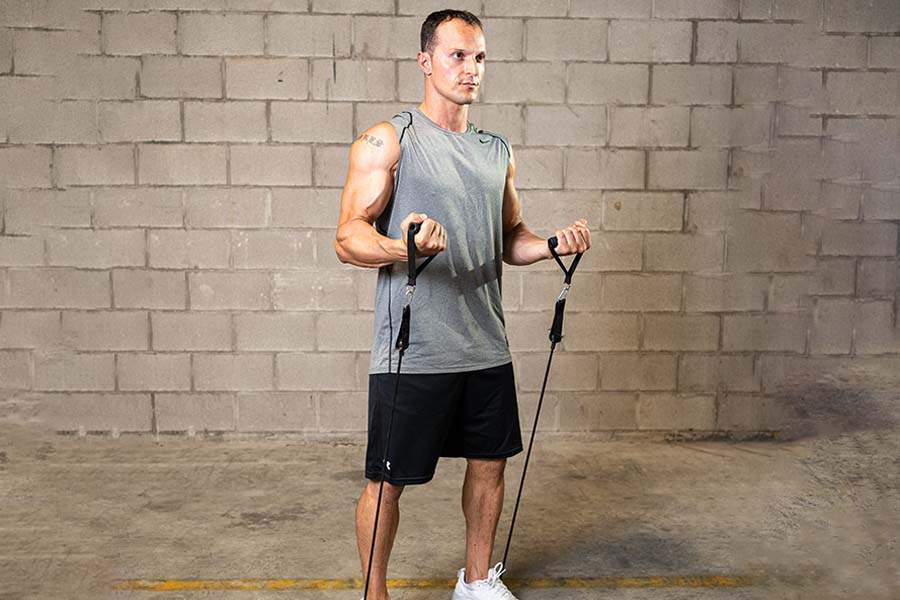Are you looking for an exciting new way to build upper body strength and show off your guns? You've come to the right place! Assisted pull-ups with resistance bands are a great way to challenge yourself, have fun, and take your workouts to the next level. Resistance bands are the latest fitness accessory that was once absent from the gymmers' repertoire, but now it is a must.
They are versatile fitness tools that can help you build strength, increase mobility, and stay fit without breaking the bank. You can use resistance bands for various exercises. One of those most challenging exercises is the pull-up.
In this article, we'll provide instructions on how to do assisted pull-ups with resistance bands correctly and explore the many benefits of incorporating them into your fitness routine. By taking just a few minutes out of your day each week, you can achieve stronger arms and a more toned upper body. So, let's dive in and see what resistance bands can do for you!
Related Article: 9 Best Resistance Band Workouts for Your Lower Body
Benefits of Resistance Bands
Resistance bands are becoming increasingly popular in the fitness community because of their numerous benefits. Here are seven benefits of using resistance bands, along with more details and facts to help you make an informed decision about incorporating them into your workouts.
Increased Strength and Endurance
Resistance bands help individuals build strength and endurance by making it easier to perform pull-ups. As users get accustomed to the assistance, they can gradually reduce the band's tension, improving their strength and form until they can perform unassisted pull-ups.
Reduced Risk of Injury
Resistance bands help reduce the risk of injury by allowing users to focus on their form and muscle engagement while performing the exercise. By providing support and assistance to the body, they help reduce the strain on the shoulder and elbow joints, which are vulnerable to injuries during pull-ups.
Improved Muscle Activation
Resistance bands help users better engage and activate their muscles, particularly in the back, arms, and core. By keeping the body stable and balanced, the bands force users to engage their core and upper body muscles more effectively, allowing for better overall muscle growth and development.
Versatile Training Tool
Resistance bands are a versatile training tool that can be utilized for a wide range of exercises, including stretching, mobility exercises, and strength training. They can also be used for other compound exercises such as dips, push-ups, and squats, making them a great addition to any workout routine.
Cost-Effective
Resistance bands are also cost-effective fitness tools that are much cheaper than buying an expensive pull-up bar or weightlifting gear. They are an affordable option that can provide similar results with proper and consistent use.
Perfect for All Fitness Levels
Resistance bands are perfect for all fitness levels, from beginners to advanced athletes. They can be used to help beginners perform their first pull-up or to help advanced athletes increase the number of reps they can perform or work on form.
Portable Fitness Equipment
Resistance bands are lightweight, portable, and easy to use, making them a perfect piece of fitness equipment for people on the go or for those who prefer to work out at home. They can easily be stored in a backpack or gym bag and can be taken with you to the park, gym, or anywhere else you want to work out.
How to Do Assisted Pull-Ups With Resistance Bands the Right Way
Assisted pull-ups with bands are the ultimate workout hack for building upper body strength and improving overall fitness. Whether you're a seasoned athlete or just starting, resistance band pull-ups offer a versatile exercise that can be done anywhere. With just a hook and a band, you can create an effective workout that targets your back, shoulders, and arms.
Let's check out the step-by-step process of doing assisted pull-ups with resistance bands to get the most out of this exercise and take your fitness to the next level.
Choose the Right Resistance Band
Before you begin, you need to choose the right resistance band. Resistance bands come in different strengths, so make sure you choose one that is appropriate for your fitness level. Start with a lighter band and work your way up to heavier resistance over time.
Find a Suitable Anchor Point
Next, you need to find a suitable anchor point. This can be a pull-up bar or any other fixed object that can support your weight. Make sure the anchor point is sturdy and will not move during your workout.
Loop the Band Around the Anchor Point
Take the resistance band and loop it around the anchor point. The band should be at about waist height when you are standing. Make sure the band is securely attached to the anchor point.
Place Your Foot on the Band
Now, step onto the resistance band with one foot. Make sure your foot is placed securely on the band and that there is tension in the band. If the band is too loose, try a heavier resistance band.
Grasp the Pull-Up Bar
Grasp the pull-up bar with both hands shoulder-width apart. Your palms should be facing away from you. Keep your arms straight and your feet firmly planted on the ground.
Start the Pull-Up
Begin the pull-up by bending your elbows and pulling your chin towards the bar. Keep your back straight and your abs tight throughout the movement.
Use the Resistance Band to Assist
The pull-up resistance band will assist as you pull yourself up towards the bar. This will make the exercise easier and allow you to complete more reps. Use as much assistance as you need, but try to use less and less assistance over time as you build strength.
Lower Yourself Down
Once you have completed the pull-up, lower yourself down slowly and with control. Keep your muscles engaged throughout the movement.
Repeat
Repeat the pull-up for as many reps as you can, using the resistance band to assist as needed. Try to increase the number of reps you can do over time.
Related Article: How Can You Switch From Weightlifting to Resistance Bands
Tips for Getting the Most From Your Assisted Pull-Ups With Bands
This challenging exercise is perfect for those who want to push themselves to the limit and see real results. But how can you make sure you're doing it right? Let's dive in and discover the secrets to mastering this powerful move.
Choose the Right Band
To get the most from your assisted pull-ups with bands, it's important to choose the right band for your fitness level. If the band is too easy, you won't get as much resistance; if it's too difficult, you may not be able to perform the exercise. Look for a band that provides moderate resistance while still allowing you to complete your reps with proper form.
Mix Up the Grips
Pull-ups can be done using different grips, including fat bar grips, wide-grip, close-grip, and neutral grips. Each grip targets different muscle groups and can add variety to your workout. Try using different grips during your assisted pull-up sets to challenge your muscles and avoid plateaus.
Keep Your Core Engaged
To get the most from your assisted pull-ups, it's important to engage your core. Keep your abs tight and your back straight throughout the exercise. This will help you maintain proper form and prevent injury.
Increase Your Reps Gradually
If you're new to assisted pull-ups, don't be discouraged if you can only do a few reps at first. Start with a small number of reps and gradually increase the number as you get stronger. Remember, quality is more important than quantity, so focus on performing each rep with proper form.
Use a Spotter for Added Safety
Consider using a spotter if you're concerned about performing assisted pull-ups with bands safely. A spotter can help you maintain proper form and prevent injury. They can also help you push through the last few reps of a set when your muscles are fatigued.
Add Exercise Variety
Assisted pull-ups with bands are a great exercise, but they shouldn't be your only upper-body workout. Try combining them with other exercises, such as push-ups, dips, and rows, for a well-rounded upper-body workout. This will help ensure that you target all the major muscle groups in your upper body and get the most from your workout.
Conclusion
Incorporating assisted pull-ups with resistance bands into your workout routine can help you build upper body strength, increase endurance, and improve overall fitness. Resistance bands are versatile and cost-effective fitness tools that offer numerous benefits, including increased muscle activation, reduced risk of injury, and portability.
By following the step-by-step process outlined in this article, you can perform assisted pull-ups with resistance bands safely and effectively. Remember to choose the right resistance band, engage your core, and gradually increase your reps over time. So go ahead - start building some serious strength!











